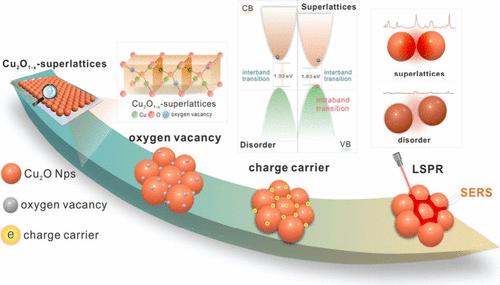Cu2O1–x-Superlattices Induced Oxygen Vacancy for Localized Surface Plasmon Resonance
IF 9.1
1区 材料科学
Q1 CHEMISTRY, MULTIDISCIPLINARY
引用次数: 0
Abstract
Metallic oxide can induce localized surface plasmon resonance (LSPR) through creating vacancies, which effectively achieve high carrier concentrations and offer advantages such as versatility and tunability. However, vacancies are typically created by altering the stoichiometric ratio of elements through doping, and it is challenging to achieve LSPR enhancement in the visible spectral range. Here, we have assembled Cu2O1–x-superlattices to induce a high concentration of oxygen vacancies, resulting in LSPR within the visible spectrum. Combining this technique with theoretical models, we have elucidated the mechanism behind the origin of LSPR. We also provide evidence of strong and uniform LSPR exhibited by this structure under visible light. This significantly enhances the electromagnetic field in semiconductor-based surface-enhanced Raman scattering (SERS), with a detection limit concentration reaching 10–9 M compared to conventional gold nanoparticles (55 nm). Our strategy provides a new perspective and potential for controlling carrier concentration and generating LSPR in metal oxide nanoparticles.

cu2o1 - x超晶格诱导局部表面等离子体共振的氧空位
金属氧化物可以通过产生空位诱导局部表面等离子体共振(LSPR),从而有效地实现高载流子浓度,并具有通用性和可调性等优点。然而,空位通常是通过掺杂改变元素的化学计量比而产生的,并且在可见光谱范围内实现LSPR增强是具有挑战性的。在这里,我们组装了cu2o3 - x超晶格来诱导高浓度的氧空位,从而在可见光谱内产生LSPR。将这一技术与理论模型相结合,我们阐明了LSPR起源背后的机制。我们还提供了该结构在可见光下表现出强而均匀的LSPR的证据。这显著增强了半导体表面增强拉曼散射(SERS)中的电磁场,与传统的金纳米颗粒(55 nm)相比,其检测极限浓度达到10-9 M。我们的策略为控制载流子浓度和在金属氧化物纳米颗粒中产生LSPR提供了新的视角和潜力。
本文章由计算机程序翻译,如有差异,请以英文原文为准。
求助全文
约1分钟内获得全文
求助全文
来源期刊

Nano Letters
工程技术-材料科学:综合
CiteScore
16.80
自引率
2.80%
发文量
1182
审稿时长
1.4 months
期刊介绍:
Nano Letters serves as a dynamic platform for promptly disseminating original results in fundamental, applied, and emerging research across all facets of nanoscience and nanotechnology. A pivotal criterion for inclusion within Nano Letters is the convergence of at least two different areas or disciplines, ensuring a rich interdisciplinary scope. The journal is dedicated to fostering exploration in diverse areas, including:
- Experimental and theoretical findings on physical, chemical, and biological phenomena at the nanoscale
- Synthesis, characterization, and processing of organic, inorganic, polymer, and hybrid nanomaterials through physical, chemical, and biological methodologies
- Modeling and simulation of synthetic, assembly, and interaction processes
- Realization of integrated nanostructures and nano-engineered devices exhibiting advanced performance
- Applications of nanoscale materials in living and environmental systems
Nano Letters is committed to advancing and showcasing groundbreaking research that intersects various domains, fostering innovation and collaboration in the ever-evolving field of nanoscience and nanotechnology.
 求助内容:
求助内容: 应助结果提醒方式:
应助结果提醒方式:


